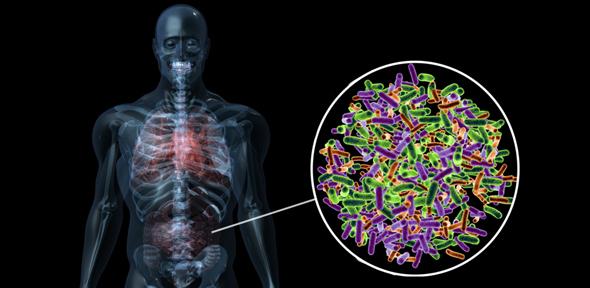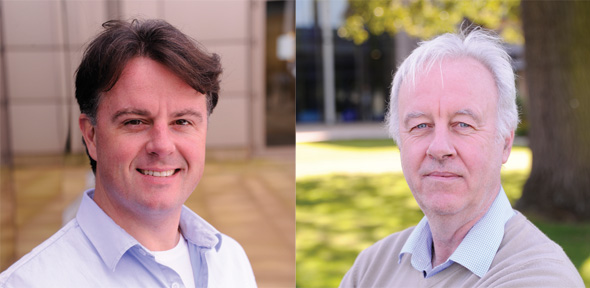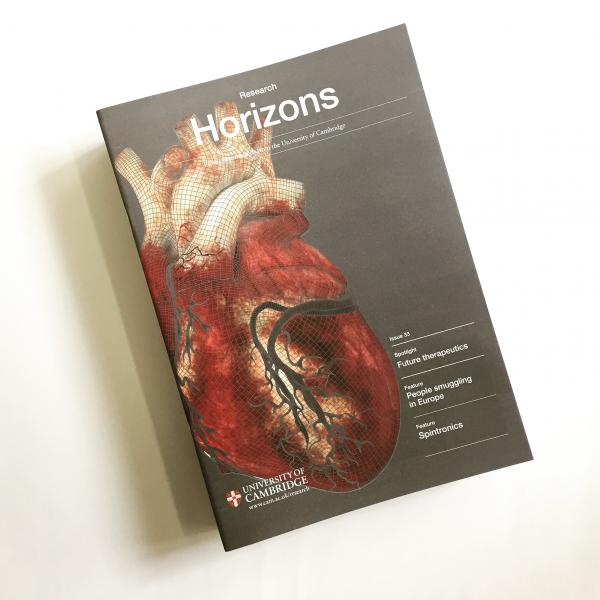
Their microbial quarry gives Dr Trevor Lawley and Professor Gordon Dougan an interesting take on the world and human interaction. When we meet at the Wellcome Trust Sanger Institute, where they both lead research groups, we shake hands. For me, it’s a social norm; for them, it’s a chance to swap bugs.
“When we shook hands, you probably got some of my spores and I got some of yours. It’s a form of kinship that we are just starting to understand,” says Lawley. “When we think about spreading bugs, we often focus on pathogens and disease. The truth is, pathogens are a tiny proportion of the whole community of diverse microorganisms that are on and within us and there’s probably an element of spreading health through this microbiome.”
The microorganisms live on our skin, up our noses and – in particularly large numbers – in our gut. The average human intestine harbours some 100 trillion bacteria from 1,000 species. They have around three million genes and make up 3% of our body weight. “We’re coated with microorganisms – bacteria, viruses, fungi – they outnumber human cells by at least three to one, so we’re more microbial than eukaryotic,” he explains.
So what are they all doing there? Although much remains a mystery, we know that changes in the microbiome appear to be linked with health and disease. They produce vitamins we cannot make ourselves and break down food to extract essential nutrients; and they help our immune systems develop and defend us against harmful bugs.
It seems that as well as being a community, our microbiome is also like an organ or tissue. “Some 30–40% of metabolites in our blood come from microbes in the intestine, so lots of our physiology and wellbeing is probably driven by factors in the gut that we don’t fully appreciate,” says Dougan, who holds a Chair in Cambridge’s Department of Medicine. “But we’re starting to realise that several human diseases are caused by pathological imbalances in these microbial communities, and that genetics, diet, antibiotics and infections can create these imbalances.”

The idea that our microbiome contributes to our health is not new. In 1908, the Russian microbiologist Ilya Mechnikov won a Nobel Prize for his discovery of phagocytes. He also sought to nurture his microbiota by consuming copious quantities of fermented milk, having noticed the longevity of yoghurt-loving Bulgarians.
Since then, the microbiome has been implicated in many areas of health and disease. “Evidence is accumulating that our microbiota can protect us against infection and inflammatory diseases of the bowel, influence factors such as obesity, and that bad microbiota, such as Clostridium difficile, can damage us,” Dougan explains. C. diff is a key part of this story. First described in the 1930s, C. diff lives in the gut of around 3% of healthy adults and, kept in check by a healthy microbiota, it does no damage. When antibiotics disrupt the microbiota, however, C. diff can be life threatening, especially among frail, elderly adults in hospitals and care homes.
In such circumstances what works best is not more antibiotics, but reintroducing gut bugs from healthy volunteers via faecal transplants. While not the most marketable of treatments, its astonishing success led Lawley and Dougan to believe that the microbiome could be an important therapeutic target.
“When I started training in Gordon’s lab ten years ago, we realised that faecal transplants could cure 90% of people with C. diff who had failed standard antibiotic treatment,” says Lawley. “That’s when we started to think that if we could identify the good bugs, we could make a medicine.”
Unfortunately, identifying the good bugs is harder than it sounds and for many years researchers lacked the necessary tools to culture them, characterise them and chart their modes of action.
Three recent advances changed all that. Genomics has helped us understand the microbiome as a whole. In 2003, scientists at Stanford University sequenced the gut microbiome (the collective genomes of all resident microorganisms) of healthy human volunteers for the first time, and 2008 saw the establishment of the Human Microbiome Project (a United States National Institutes of Health initiative). Then, germ-free mice provided researchers with a model system to test their ideas. Finally, Lawley discovered a way of growing gut bacteria in the lab – something that for decades was thought impossible.
“One of the things we had to overcome – a dogma as well as a technical barrier – was to culture the unculturable,” he says. “Now, we are culturing at scale and sequencing. This means we have access to the bugs to follow up and work out what they do, and then even to make a medicine from.”
Buoyed by their success, the Sanger Institute last year spun out a new company – Microbiotica – to exploit their unique capabilities in microbiome science, particularly in culture collection, genome database and animal models, to develop new medicines.

“We’re collecting samples of poo from around the world – from Vietnam and India to Nigeria and Kenya – to build a globally representative collection of microbiome bacteria. No-one else has such a large and diverse collection,” Dougan says. “It will allow us to mine these isolates – and their genomes – for new antibiotics and design new bacterial-based therapies.”
As well as finding a more palatable alternative to faecal transplants for C. diff infections, Lawley and Dougan have their sights set on using bugs as drugs in other areas. There is strong evidence that both inflammatory bowel disease (which affects around 0.5% of the population) and irritable bowel syndrome (which affects 15–20%) result from a damaged microbiome, so these conditions are prime candidates.
Lawley and Dougan are also working with Imperial College London to study links between the lung microbiome and chronic obstructive pulmonary disease and asthma, as well as the microbiome differences of babies born by C-section versus vaginal delivery. They are also working with American collaborators on the bladder, where the hallmark of a healthy microbiome is very different to that of the gut.
“In the gut, the signature of health is diverse microbes. In the vagina and the bladder, it’s the opposite – simplified is healthy. Once they become diverse, there’s something wrong,” explains Lawley, who is also Chief Scientific Officer at Microbiotica.
The researchers are also working on some cancers for which modern immunotherapies are successful against the disease but cannot be used in some patients because they damage the microbiome so badly. “We’re involved in MelResist, a multi-university collaboration on new therapies for melanoma. Long-term survival in melanoma patients treated with antibody therapies is now a remarkable 50%,” says Lawley. “But if they have two different antibodies, they can develop life-threatening diarrhoea and colitis and have to stop treatment – we think there’s a microbiome element there.”
It’s a far cry from Bulgarian yoghurt, and while there’s much science yet to be done, and many regulatory challenges to bring an entirely new kind of medicine to market, it’s a challenge they relish. “We want to innovate and encourage links and partnerships with other organisations,” Dougan concludes. “It’s a whole new science – but we’re confident that we can deliver new medicines.”
Inset images: Trevor Lawley (left) and Gordon Dougan; credit: Wellcome Trust Sanger Institute.
Read more about research on future therapeutics in Research Horizons magazine.
Trevor Lawley and Gordon Dougan are bug hunters, albeit not the conventional kind. The bugs they collect are invisible to the naked eye. And even though we’re teeming with them, researchers are only beginning to discover how they keep us healthy – and how we could use these bugs as drugs.

The text in this work is licensed under a Creative Commons Attribution 4.0 International License. For image use please see separate credits above.